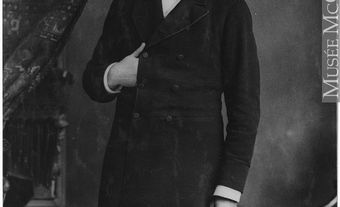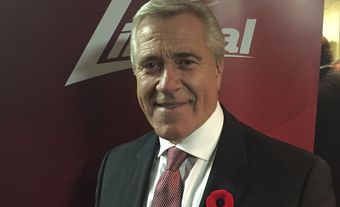
Early Life and Career
Joseph Roberts Smallwood was born 24 December 1900 at Mint Brook, near Gambo, Newfoundland, and raised in poverty in St. John’s. His education began in local schools in St. John’s before his Uncle Fred helped him enroll as a boarder at Bishop Feild College. He left the school in 1915 without completing his studies, and apprenticed as a printer at the St. John’s Plaindealer, a local newspaper. Largely self-taught, Smallwood became well versed in the labour movement and social reform issues (see Working Class History — English Canada). While working as a typesetter, he gained experience as a journalist and even covered the first non-stop transatlantic flights in 1919.
Smallwood went on to live and work in New York for the better part of five years (he returned to Canada a number of times between 1920 and 1925). During that time, he held positions at left-wing dailies The New York Call and The New Leader, as well as The New York Times and a newspaper syndicate. During the 1924 presidential election, Smallwood campaigned for the Socialist Party of America, which was affiliated with The New York Call. He was a self-proclaimed "socialist."
Returning to Newfoundland in 1925, he became a union organizer and radio broadcaster. He continued working in the newspaper industry, founding the Labour Outlook. After returning from a trip to England in 1926, he established himself in Corner Brook, Newfoundland, and founded the Humber Herald.
Smallwood planned to run as a Liberal candidate for Humber in 1928, but ceded the privilege to party leader Sir Richard Squires and served as district campaign manager instead. He was rewarded for his work with an appointment as justice of the peace. Smallwood was unsuccessful in his bid to represent Bonavista South in 1932.
During the Second World War, he ran a pig farm at the air base in Gander, Newfoundland, and his second opportunity to enter politics emerged in 1946 with the announcement of a National Convention. Britain's new Labour government announced that Newfoundlanders, then governed as a protectorate by an appointed Commission of Government, could elect representatives who would advise the government on Newfoundland’s political future. Smallwood, who favoured Confederation with Canada, was elected to the Convention as a delegate for Bonavista Centre.
Political Career and Confederation
During the years of the National Convention (1946–47), Joey Smallwood established himself as the leading proponent of Confederation. He demonstrated willpower, courage and ruthlessness in the political ring, and mastered populist propaganda to make himself an exceptional contemporary politician. Smallwood believed that union with Canada would bring prosperity to Newfoundland and improve Newfoundlanders’ quality of life by giving them access to North American standards of social welfare and public services. Smallwood dominated the National Convention debates, despite opposition from influential St. John's merchants who accused him of betraying Newfoundland’s independence. In a memorable speech during the debates, he told Newfoundlanders the bitter truth: "We are not a nation. We are a medium-sized municipality [...] left far behind in the march of time."
Smallwood was a member of the first delegation sent to Ottawa in 1947 to discuss the potential terms of Newfoundland’s union with Canada. He was instrumental in having Confederation included on the ballot for the referendum that followed the National Convention. The referendum was to decide what form of government Newfoundland would pursue — to continue with the Commission of Government, return to responsible government, or join Confederation as Canada’s 10th province.)
Smallwood served as campaign manager for the Confederate Association, which formed on 21 February 1948. The Confederate Association officially launched its referendum campaign 7 April 1948, and its newspaper, The Confederate, was edited by Smallwood. Smallwood won the second of two hard-fought and close referenda on 22 July 1948 with the promise of increased social services, including employment insurance, family allowances (also known as the “baby bonus”), stronger pensions, and a lower cost of living. Following this success, Smallwood was included as a member of the delegation to negotiate Newfoundland’s final terms of union with Canada. He was appointed premier of the interim government 1 April 1949, elected leader of the Liberal Party, and he won the first provincial election in May 1949. He was not seriously challenged as premier for two decades. (See alsoNewfoundland and Labrador and Confederation; Newfoundland Joins Confederation.)
Life and Career after Confederation
As minister of economic development, Smallwood had a direct hand in the development and industrialization efforts in Newfoundland and Labrador. He encouraged foreign investments to help build factories and spur the growth of new industries. Smallwood’s economic advisor and director of economic development, Alfred A. Valdmanis, helped facilitate investments from a number of German investors but nothing substantial materialized. Valdmanis was, however, taking kickbacks from the builders hired to build cement and gypsum plants. He was arrested in April 1954, and convicted of embezzlement in September 1954.
Smallwood also cultivated close relationships with industrial tycoons, including John C. Doyle (mining) and John Shaheen (oil). Smallwood facilitated Doyle’s acquisition of land and mining rights around Wabush Lake in Labrador (see Wabush) and overlooked the shady financial dealings of his company Canadian Javelin. Shaheen’s proposal to build an oil refinery at Come By Chance, Newfoundland, resulted in one of largest bankruptcies in Canadian history.
In pursuit of a robust economy, Smallwood sought to develop the province’s natural resources. He became obsessed with the Churchill Falls hydroelectric power project, even though it proved a logistical nightmare to develop and the 1969 contract brought few economic benefits to the province. It tarnished Smallwood’s career.
The 1959 Badger Riot was another stain on Smallwood’s career and diminished his early credibility as an advocate for workers (see Newfoundland Loggers Strike). The conflict originated when loggers asked the International Woodworkers of America (IWA) to replace the Newfoundland Loggers Association (NLA) as their representative. The latter, with the support of the logging company, opposed that decision. In 1959, Smallwood bolstered the company and the NLA by decertifying the IWA and creating legislation that nullified the collective bargaining rights of loggers and trade unions in general. In protest, the IWA led a strike to which the loggers added their grievances about low pay and poor working conditions. On 10 March 1959, tensions erupted and one member of the Newfoundland Constabulary was clubbed by a striker and later died. The International Labour Organization, Canadian Labour Congress, and Prime Minister John Diefenbaker condemned Smallwood’s management of the situation.
Despite that, Smallwood and his Liberals are known for building schools, hospitals, and roads. To provide services to Newfoundlanders, however, residents in remote communities (known as outports) were resettled to “growth centres.” The experience produced a sense of deep dislocation among a generation of Newfoundlanders.
After he initially announced his intention to retire in 1968, Smallwood had difficulty letting go of his political career and changed his mind a few times. He survived a challenge from disaffected Cabinet minister John Crosbie at the 1969 Liberal leadership convention. But in the October 1971 election, the Conservatives led by Frank Moores won 21 seats, Smallwood 20 seats, and the New Labrador Party 1 seat. Smallwood resigned as leader 18 January 1972, and vacated his seat soon after. He tried unsuccessfully to win back the Liberal leadership in 1974. He formed the Liberal Reform Party, which won 4 seats in the 1975 election. In 1977, he rejoined the Liberals but relinquished his seat and exited politics in June of the same year.
In retirement, he returned to writing, most notably his Encyclopedia of Newfoundland and Labrador (volume 1, 1981; volume 2, 1984). Three remaining volumes were published posthumously (volume 3, 1991; volume 4, 1993; volume 5, 1994) by Harry Cuff Publications for the Joseph R. Smallwood Heritage Foundation. The proceeds of the book sales were given to the J.R. Smallwood Centre for Newfoundland Studies at Memorial University. In December 1986, Smallwood was made a Companion of the Order of Canada.
Popular Culture
Smallwood was the subject of the National Film Board of Canada’s feature-length documentary A Little Fellow from Gambo: The Joey Smallwood Story (1970). The documentary follows the 1969 Liberal leadership convention in Newfoundland, in which Smallwood, who had been premier for 20 years, was challenged as party leader.
A Little Fellow from Gambo - The Joey Smallwood Story, Julian Biggs, provided by the National Film Board of Canada
In 1974, Smallwood appeared in another feature-length NFB documentary called Waiting for Fidel. At that point a private citizen, Smallwood travelled to Cuba with radio and TV station owner Geoff Stirling and director Michael Rubbo to interview Cuban dictator Fidel Castro. Smallwood, a self-described socialist, and Stirling, a devout capitalist, debate the status of the communist state while awaiting an interview with Castro that never materializes.
Smallwood has been depicted in fictionalized accounts of his political career, including the CBC TV movie Joey (1982) and Wayne Johnston’s novel The Colony of Unrequited Dreams (1998). In 2015, Artistic Fraud of Newfoundland, a theatre company based in St. John’s, mounted its adaptation of The Colony of Unrequited Dreams. The play was staged in Ottawa, Halifax and London in 2017.
Legacy
As the leading proponent of Confederation, Joey Smallwood is often referred to as Newfoundland’s “Father of Confederation.” Smallwood’s legacy is contentious. He is praised for his accomplishments in improving roads, schools, and social services in Newfoundland and Labrador. But he is also criticized for his failed efforts at fostering industrial development in Newfoundland and Labrador, as well as his increasingly autocratic rule over his long tenure in office.
Joey Smallwood died 17 December 1991 in St. John's, Newfoundland, just a few days before he would have turned 91.

 Share on Facebook
Share on Facebook Share on X
Share on X Share by Email
Share by Email Share on Google Classroom
Share on Google Classroom




